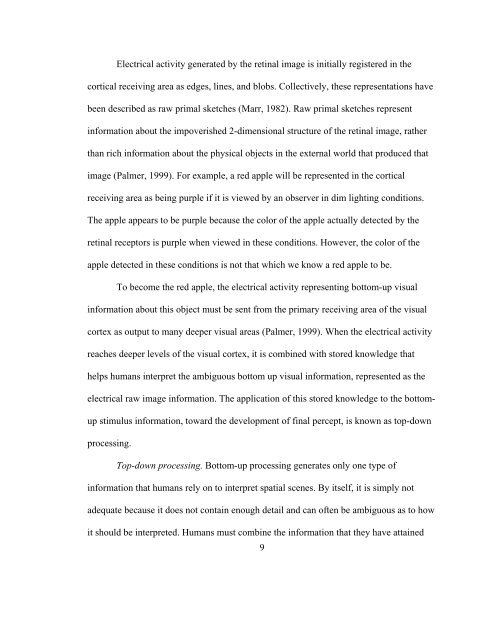The Use of Iambic Pentameter in the
The Use of Iambic Pentameter in the
The Use of Iambic Pentameter in the
Create successful ePaper yourself
Turn your PDF publications into a flip-book with our unique Google optimized e-Paper software.
Electrical activity generated by <strong>the</strong> ret<strong>in</strong>al image is <strong>in</strong>itially registered <strong>in</strong> <strong>the</strong><br />
cortical receiv<strong>in</strong>g area as edges, l<strong>in</strong>es, and blobs. Collectively, <strong>the</strong>se representations have<br />
been described as raw primal sketches (Marr, 1982). Raw primal sketches represent<br />
<strong>in</strong>formation about <strong>the</strong> impoverished 2-dimensional structure <strong>of</strong> <strong>the</strong> ret<strong>in</strong>al image, ra<strong>the</strong>r<br />
than rich <strong>in</strong>formation about <strong>the</strong> physical objects <strong>in</strong> <strong>the</strong> external world that produced that<br />
image (Palmer, 1999). For example, a red apple will be represented <strong>in</strong> <strong>the</strong> cortical<br />
receiv<strong>in</strong>g area as be<strong>in</strong>g purple if it is viewed by an observer <strong>in</strong> dim light<strong>in</strong>g conditions.<br />
<strong>The</strong> apple appears to be purple because <strong>the</strong> color <strong>of</strong> <strong>the</strong> apple actually detected by <strong>the</strong><br />
ret<strong>in</strong>al receptors is purple when viewed <strong>in</strong> <strong>the</strong>se conditions. However, <strong>the</strong> color <strong>of</strong> <strong>the</strong><br />
apple detected <strong>in</strong> <strong>the</strong>se conditions is not that which we know a red apple to be.<br />
To become <strong>the</strong> red apple, <strong>the</strong> electrical activity represent<strong>in</strong>g bottom-up visual<br />
<strong>in</strong>formation about this object must be sent from <strong>the</strong> primary receiv<strong>in</strong>g area <strong>of</strong> <strong>the</strong> visual<br />
cortex as output to many deeper visual areas (Palmer, 1999). When <strong>the</strong> electrical activity<br />
reaches deeper levels <strong>of</strong> <strong>the</strong> visual cortex, it is comb<strong>in</strong>ed with stored knowledge that<br />
helps humans <strong>in</strong>terpret <strong>the</strong> ambiguous bottom up visual <strong>in</strong>formation, represented as <strong>the</strong><br />
electrical raw image <strong>in</strong>formation. <strong>The</strong> application <strong>of</strong> this stored knowledge to <strong>the</strong> bottom-<br />
up stimulus <strong>in</strong>formation, toward <strong>the</strong> development <strong>of</strong> f<strong>in</strong>al percept, is known as top-down<br />
process<strong>in</strong>g.<br />
Top-down process<strong>in</strong>g. Bottom-up process<strong>in</strong>g generates only one type <strong>of</strong><br />
<strong>in</strong>formation that humans rely on to <strong>in</strong>terpret spatial scenes. By itself, it is simply not<br />
adequate because it does not conta<strong>in</strong> enough detail and can <strong>of</strong>ten be ambiguous as to how<br />
it should be <strong>in</strong>terpreted. Humans must comb<strong>in</strong>e <strong>the</strong> <strong>in</strong>formation that <strong>the</strong>y have atta<strong>in</strong>ed<br />
9

















